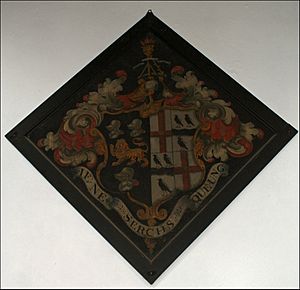Hatton Compton facts for kids
Hatton Compton was an English army officer. He held important jobs at the Tower of London for many years. From 1713 to 1741, he was the Lieutenant of the Tower of London. He also served as Lord Lieutenant of the Tower Hamlets from 1715 to 1717.
Contents
Hatton Compton's Early Life and Family
Hatton Compton was one of five children. His father was Sir Charles Compton from Grendon and Sywell in Northamptonshire. His mother was Mary. Hatton Compton inherited Grendon Hall from his father. He made the house much bigger.
In 1686, Compton was injured in a duel. This fight happened because of a disagreement between his cousin and another family.
In 1698, Hatton Compton married his cousin, Penelope Nicholas. They had three sons and one daughter:
- Charles (died 1761) became a fellow at Gonville and Caius College, Cambridge. He was also a treasurer for the Society of Antiquaries of London.
- Edward (died 1769) worked as a cashier for army officers. His son, William, later became a chancellor.
- James married Frances Riggs in New York City in 1736. Their daughter, Penelope, married John Pennington, 1st Baron Muncaster.
- Mary (born around 1708) married Thomas Gooch. He was a bishop and a master at Gonville and Caius College.
Hatton Compton lived in Soho, London. He moved to Dean Street in 1713. Later, in 1728, he moved to a house in Great Marlborough Street.
Hatton Compton's Military Career
Joining the Army and Early Support
Compton began his army career on July 1, 1685. He was a cornet in the Royal Horse Guards. This was a cavalry unit. His uncle, Sir Francis Compton, commanded his troop.
During the Glorious Revolution in 1688, Compton supported the future King William III. He met with other important leaders and generals. Around November 7, 1688, Compton and some of his men left King James II. They joined William III's side. This action was mentioned in a diary from that time. Because of his loyalty, King William made him a Groom of the Bedchamber. This was an important position in the royal household.
Promotions and Key Battles
Compton continued to rise through the ranks. In 1691, he became a guidon and major in the 3rd Troop of Horse Guards. The next year, in 1692, he was promoted to lieutenant-colonel.
In 1693, during the Battle of Landen, Compton played a heroic role. He helped prevent King William from being captured. For this bravery, he was promoted to colonel in 1694. He became a brigadier in 1702. Then, he was promoted to major general in 1704. Finally, he became a lieutenant general in 1707. He retired from the Guards in 1718.
Service at the Tower of London
Lieutenant of the Tower
In 1712, Hatton Compton's cousin, the 4th Earl of Northampton, became the Constable of the Tower. This was the main governor of the Tower of London. That same year, Northampton appointed Hatton Compton as the Lieutenant of the Tower of London. This was the second-in-command position.
Compton also became the Lord Lieutenant of the Tower Hamlets in 1715. This role involved overseeing the local militia.
Role During the Jacobite Rising
In 1715, there was a rebellion called the Jacobite rising of 1715. This was a time of high security. Hatton Compton remained Lord Lieutenant to manage the militia. He wrote to the government, saying that the Tower Hamlets had "two very strong Regiments of Foot" ready to march. He also ordered searches for people who supported the Jacobite cause. He helped create a loyal group in the Tower Hamlets. This group quickly grew to over 3,000 members.
Handling Prisoners
As Lieutenant of the Tower, Compton was in charge of prisoners. When Robert Harley, 1st Earl of Oxford was imprisoned, Compton held him in a part of the Tower used by the Royal Mint. This caused problems for Isaac Newton, who was the Master of the Mint at the time.
Compton was also responsible for Jacobite lords imprisoned in the Tower. When the Earl of Nithsdale escaped, Compton put his guards in jail. When the Earl of Winton escaped, Compton blamed the guards for being careless. He said only the Constable could fire them.
Compton remained Lieutenant of the Tower until he died in 1741.


